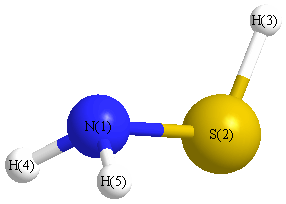Jump to
S1C2
Energy calculated at QCISD(T)/cc-pVDZ
| | hartrees |
|---|
| Energy at 0K | -454.052931 |
| Energy at 298.15K | -454.056625 |
| HF Energy | -453.702618 |
| Nuclear repulsion energy | 56.582795 |
The energy at 298.15K was derived from the energy at 0K
and an integrated heat capacity that used the calculated vibrational frequencies.
Vibrational Frequencies calculated at QCISD(T)/cc-pVDZ
| Mode Number |
Symmetry |
Frequency
(cm-1) |
Scaled Frequency
(cm-1) |
IR Intensities
(km mol-1) |
Raman Act
(Å4/u) |
Dep P |
Dep U |
|---|
| 1 |
A' |
3472 |
3309 |
|
|
|
|
| 2 |
A' |
2689 |
2563 |
|
|
|
|
| 3 |
A' |
1623 |
1547 |
|
|
|
|
| 4 |
A' |
1042 |
993 |
|
|
|
|
| 5 |
A' |
929 |
886 |
|
|
|
|
| 6 |
A' |
661 |
630 |
|
|
|
|
| 7 |
A" |
3566 |
3399 |
|
|
|
|
| 8 |
A" |
1140 |
1087 |
|
|
|
|
| 9 |
A" |
359 |
342 |
|
|
|
|
Unscaled Zero Point Vibrational Energy (zpe) 7740.8 cm
-1
Scaled (by 0.9531) Zero Point Vibrational Energy (zpe) 7377.7 cm
-1
See section
III.C.1 List or set vibrational scaling factors
to change the scale factors used here.
See section
III.C.2
Calculate a vibrational scaling factor for a given set of molecules
to determine the least squares best scaling factor.
Geometric Data calculated at QCISD(T)/cc-pVDZ
Point Group is Cs
Cartesians (Å)
| Atom |
x (Å) |
y (Å) |
z (Å) |
|---|
| N1 |
0.010 |
1.142 |
0.000 |
| S2 |
0.010 |
-0.630 |
0.000 |
| H3 |
-1.339 |
-0.766 |
0.000 |
| H4 |
0.559 |
1.429 |
0.817 |
| H5 |
0.559 |
1.429 |
-0.817 |
Atom - Atom Distances (Å)
| |
N1 |
S2 |
H3 |
H4 |
H5 |
| N1 | | 1.7726 | 2.3366 | 1.0260 | 1.0260 |
S2 | 1.7726 | | 1.3552 | 2.2827 | 2.2827 | H3 | 2.3366 | 1.3552 | | 3.0148 | 3.0148 | H4 | 1.0260 | 2.2827 | 3.0148 | | 1.6349 | H5 | 1.0260 | 2.2827 | 3.0148 | 1.6349 | |
 More geometry information
More geometry information
Calculated Bond Angles
| atom1 |
atom2 |
atom3 |
angle |
|
atom1 |
atom2 |
atom3 |
angle |
| N1 |
S2 |
H3 |
95.750 |
|
S2 |
N1 |
H4 |
106.220 |
| S2 |
N1 |
H5 |
106.220 |
|
H4 |
N1 |
H5 |
105.639 |
Electronic energy levels
Charges, Dipole, Quadrupole and Polarizability
Jump to
S1C1
Energy calculated at QCISD(T)/cc-pVDZ
| | hartrees |
|---|
| Energy at 0K | -454.051849 |
| Energy at 298.15K | -454.055650 |
| HF Energy | -453.702648 |
| Nuclear repulsion energy | 56.872430 |
The energy at 298.15K was derived from the energy at 0K
and an integrated heat capacity that used the calculated vibrational frequencies.
Vibrational Frequencies calculated at QCISD(T)/cc-pVDZ
| Mode Number |
Symmetry |
Frequency
(cm-1) |
Scaled Frequency
(cm-1) |
IR Intensities
(km mol-1) |
Raman Act
(Å4/u) |
Dep P |
Dep U |
|---|
| 1 |
A' |
3479 |
3316 |
|
|
|
|
| 2 |
A' |
2599 |
2477 |
|
|
|
|
| 3 |
A' |
1609 |
1534 |
|
|
|
|
| 4 |
A' |
1044 |
995 |
|
|
|
|
| 5 |
A' |
892 |
850 |
|
|
|
|
| 6 |
A' |
654 |
623 |
|
|
|
|
| 7 |
A" |
3582 |
3414 |
|
|
|
|
| 8 |
A" |
1127 |
1074 |
|
|
|
|
| 9 |
A" |
490 |
467 |
|
|
|
|
Unscaled Zero Point Vibrational Energy (zpe) 7737.5 cm
-1
Scaled (by 0.9531) Zero Point Vibrational Energy (zpe) 7374.6 cm
-1
See section
III.C.1 List or set vibrational scaling factors
to change the scale factors used here.
See section
III.C.2
Calculate a vibrational scaling factor for a given set of molecules
to determine the least squares best scaling factor.
Geometric Data calculated at QCISD(T)/cc-pVDZ
Point Group is Cs
Electronic energy levels
Charges, Dipole, Quadrupole and Polarizability
